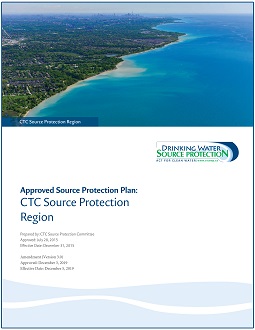Under the Clean Water Act 2006, each Source Protection Area must produce a Source Protection Plan (SPP). The SPP for the CTC Source Protection Region came into effect on December 31, 2015.
The CTC Source Protection Plan amendment linked below was approved on February 23, 2022 and came into effect on March 2, 2022.
The CTC Source Protection Plan applies to all three Source Protection Areas in the Region: Credit Valley, Toronto and Region and Central Lake Ontario.
The Plan applies immediately to all new threat activities, and includes timelines for bringing all current threat activities into compliance with the SPP policies. These threats have been identified through technical and scientific work described in the Assessment Reports.
Note to SPP readers: In July 2020, the implementation deadline for SPP policy T-6 was extended by 3 years until Dec. 31, 2023.
Note to SPP readers: Following June/July 2023 public consultation, the most recent amendments to the CTC Source Protection Plan were approved on February 29, 2024 and came into effect on March 6, 2024. The amended CTC Source Protection Plan will be posted here in the near future. Please contact us with any questions regarding the recently approved amendments.
The Source Protection Plan (SPP) is a strategy and suite of policies designed to protect municipal sources of drinking water from contamination and overuse. Developed by a multi-stakeholder committee made up of watershed residents, business leaders, and municipalities, an SPP outlines proactive measures that, when implemented, will safeguard the water quality and quantity of municipal drinking water systems.
Under the Clean Water Act, 2006, each Source Protection Area in Ontario must develop a plan for keeping sources of drinking water clean and encouraging wise water use. A Source Protection Plan sets out policies to:
- Safeguard Human Health
- Ensure Adequate Safe, Clean Water Is Available
- Protect Current and Future Sources of Municipal Drinking Water From Significant Threat Activities
A Source Protection Plan must have policies that address “significant drinking water threats,” and may also contain policies that address “low” and “moderate” drinking water threats. It specifies how the risk level of identified threats is to be reduced, and how future threats will be avoided.
A Source Protection Plan is about more than just the science of source water protection. It is, in large part, about the impact of land use on drinking water quality and quantity.
What Is An Assessment Report?
To protect our drinking water, we need to understand what’s going on in the surrounding watershed — both above and below ground. An Assessment Report looks at all of the factors influencing the quality and quantity of water within a watershed.
A key requirement of the Clean Water Act, 2006, an Assessment Report is the scientific backbone on which policies rest. It includes information such as:
- The physical characteristics of the land in the watershed
- Land use
- The location of drinking water sources
- How much water is being used and how much is available for future uses
- Where vulnerable water sources are located
- Potential threats that may compromise drinking water sources, whether through contamination or overuse
The CTC Source Protection Committee was responsible for the development of Assessment Reports for each of the Source Protection Areas within the CTC Source Protection Region:
- Credit Valley Source Protection Area
- Toronto and Region Source Protection Area
- Central Lake Ontario Source Protection Area
These Assessment Reports are based on detailed technical studies, and underwent a rigorous peer review process. They are considered “living documents,” subject to ongoing updates and amendments as new information becomes available.
This brochure provides a comprehensive overview of the Assessment Reports and Source Protection Plan.
TECHNICAL DOCUMENTS
- Credit Valley Source Protection Area
- Toronto and Region Source Protection Area
- Central Lake Ontario Source Protection Area
In November 2009, the Ministry of the Environment issued amended technical rules to guide the development of Assessment Reports across Ontario:

